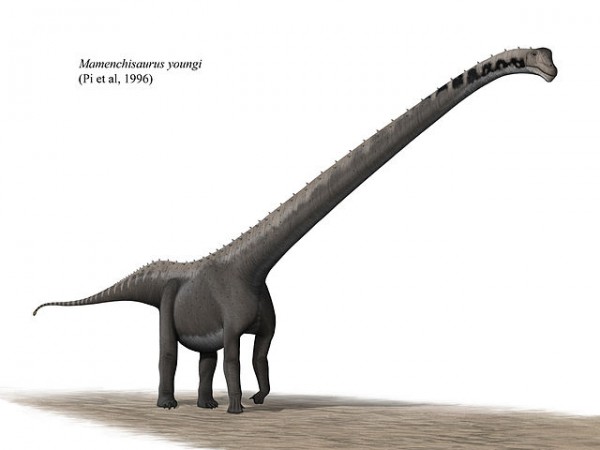New Dinosaur Species with Dragon-like Neck Found in China
| Marco Foronda | | Jan 30, 2015 07:55 AM EST |
(Photo : wikipedia.org) An artist's impression of M. youngi
Paleontologists at the University of Alberta have discovered a new species of a long-necked dinosaur called "Qijianglong" based on a skeleton found in China.
The new dinosaur species has one of the longest necks relative to total body size that has ever been found, said Professor Philip Currie of University of Alberta.
Like Us on Facebook
A construction team working in the Qijiang District in central China spotted the fossils in 2006. They found Qijianglong's fossil head with its neck still intact.
Research revealed Qijianglong was 50 feet in length and lived near Qijiang City in China about 160 million years ago. Its neck is described as unique to its dinosaur group called mamenchisaurids.
The neck is more than one-half the animal's length. It contained air pockets that made it lighter so muscles could support the large and weighty neck.
The study also suggests the dinosaur's vertebrae were different from any other species of mamenchisaurid and added support to the long neck.
Currie said this type of dinosaur is unique to Asia and there are still no samples of mamenchisaurids discovered in any other country. The researchers concluded that a land barrier or a body of water blocked the dinosaur from moving to other countries.
Its name Qijanglong means "dragon of Qijiang." Researchers suggest identical fossils may have been the origin of dragon legends in China.
"China is home to the ancient myths of dragons. I wonder if the ancient Chinese stumbled upon a skeleton of a long-necked dinosaur like Qijanglong and pictured that mythical creature," said Tetsuto Miyashita, one of the authors on the study.
Paleontologists said Qijanglong's discovery is an important evolutionary chapter in the history of sauropods because it shows the extensive diversification among these beasts in Asia didn't occur elsewhere.
News of the new discovery appeared in the Journal of Vertebrate Paleontology.
Tagsnew species dinosaur, long-necked dinosaur, mamenchisaurids, Dinosaur era, dragons, ancient myths of dragons
©2015 Chinatopix All rights reserved. Do not reproduce without permission
EDITOR'S PICKS
-

Did the Trump administration just announce plans for a trade war with ‘hostile’ China and Russia?
-

US Senate passes Taiwan travel bill slammed by China
-

As Yan Sihong’s family grieves, here are other Chinese students who went missing abroad. Some have never been found
-

Beijing blasts Western critics who ‘smear China’ with the term sharp power
-

China Envoy Seeks to Defuse Tensions With U.S. as a Trade War Brews
-

Singapore's Deputy PM Provides Bitcoin Vote of Confidence Amid China's Blanket Bans
-

China warns investors over risks in overseas virtual currency trading
-

Chinese government most trustworthy: survey
-

Kashima Antlers On Course For Back-To-Back Titles
MOST POPULAR
LATEST NEWS
Zhou Yongkang: China's Former Security Chief Sentenced to Life in Prison

China's former Chief of the Ministry of Public Security, Zhou Yongkang, has been given a life sentence after he was found guilty of abusing his office, bribery and deliberately ... Full Article
TRENDING STORY

China Pork Prices Expected to Stabilize As The Supplies Recover

Elephone P9000 Smartphone is now on Sale on Amazon India

There's a Big Chance Cliffhangers Won't Still Be Resolved When Grey's Anatomy Season 13 Returns

Supreme Court Ruled on Samsung vs Apple Dispute for Patent Infringement

Microsoft Surface Pro 5 Rumors and Release Date: What is the Latest?










